Advatronix Nimbus 400 File Server Review
by Ganesh T S on August 12, 2015 8:00 AM EST- Posted in
- NAS
- storage server
- Avoton
- Advatronix
Performance Metrics - Phoronix Test Suite
The file server's BIOS settings allow it boot off a USB key. We had no trouble doing the same with a portable installation of Ubuntu 14.04 (kernel version 3.16).
Database Benchmarks
The first test we look at involves determination of the time taken to perform 12500 record insertions into an indexed database. We use SQLite v3.7.3. SQLite performance depends to a large extent on the capabilities of the CPU. Note that the C2750D4I system has a 20W TDP and has more cores / better clocks compared to the C2550D4I in the Nimbus 400. Benchmarks from other systems can be viewed on OpenBenchmarking.org.
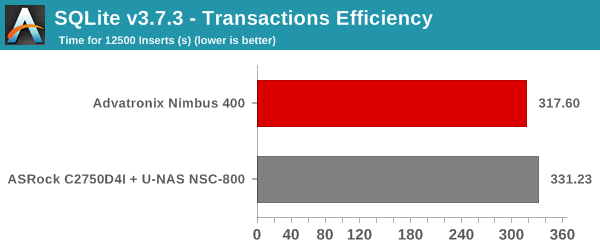
The pgbench database benchmark involves recording the transaction rate for database operations using PostgreSQL. Unlike SQLite insertions-only test, pgbench is based on TPC-B, running five SELECT, UPDATE and INSERT commands per transaction.
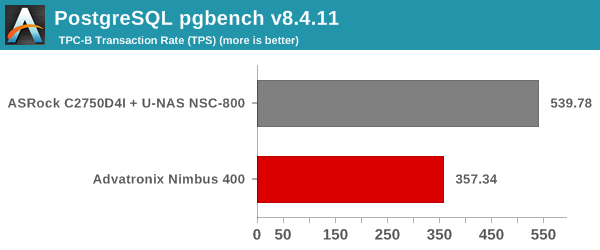
Benchmarks from other systems can be viewed on OpenBenchmark.org
Web Server Benchmarks
The NGINX and Apache benchmarks record the number of static web page requests that can be serviced in a given time interval. It gives an idea of the load that can be handled if a given system were to be configured as a web server. The test load consists of a total of 500K requests (for NGINX) / 1M requests (for Apache) with 100 concurrent ones.

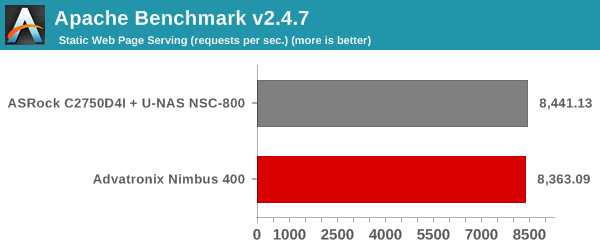
Benchmark numbers for both of these are available on OpenBenchmarking.org (NGINX, Apache).
TCP Loopback
The efficiency of the networking stack in the system (not to be confused with the hardware network adapter itself) can be determined by measures the loopback TCP performance. We record the time taken to transfer 10GB of data via loopback.

Given that we have the same networking stack for a given OS release across different hardware configurations, the efficiency is going to vary based solely on the CPU capabilities again. Benchmarks from other systems can be viewed on OpenBenchmarking.org.
CacheBench
CacheBench is an artificial benchmark to determine the performance of the cache and DRAM components in a system. It consists of three profiles - reads, writes and read/modify/writes. The bandwidth is recorded for each profile, with bigger numbers indicating better performance.
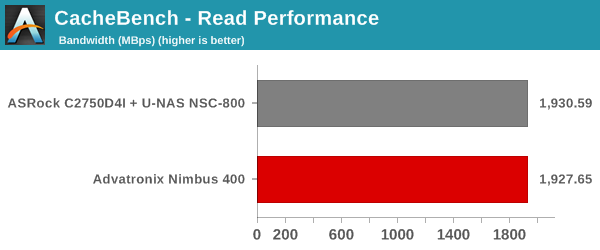
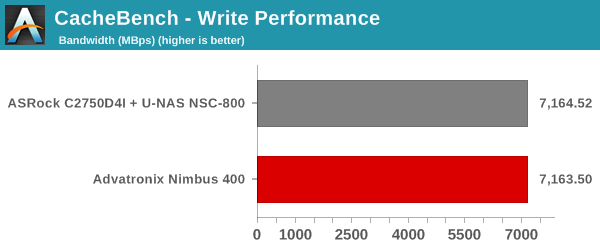
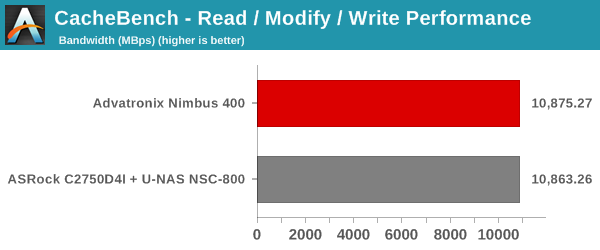
The numbers depend on the internal cache access speeds as well as the speed of the DRAM in the system. Benchmarks from other systems can be viewed on OpenBenchmarking.org
Stream
The system memory is tested out using the stream benchmark. The STREAM benchmark is a simple, synthetic benchmark designed to measure sustainable memory bandwidth (in MB/s) and a corresponding computation rate for four simple vector kernels (Copy, Scale, Add and Triad).
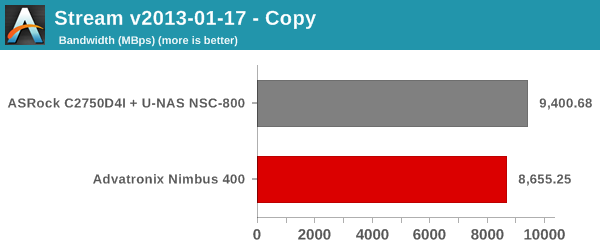
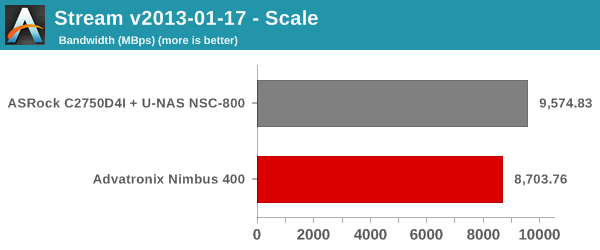

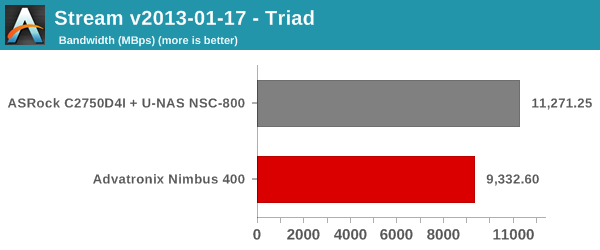
7-Zip Compression
The 7-Zip compression benchmark records the MIPS for the compression mode. This is the same benchmark that we use in the evaluation of mini-PCs, except that this is based on the Linux version. Higher MIPS ratings correspond to better performance, and the numbers are primarily based on the performance of the CPU in the system.

Benchmark numbers for other systems can be viewed on OpenBenchmarking.org
Linux Kernel Compilation
The timed Linux kernel compilation benchmark records the time taken to build the Linux 3.18 kernel. It is a good multi-discipline benchmark, stressing multiple aspects of the system including the DRAM, CPU and, to a certain extent, even the storage.
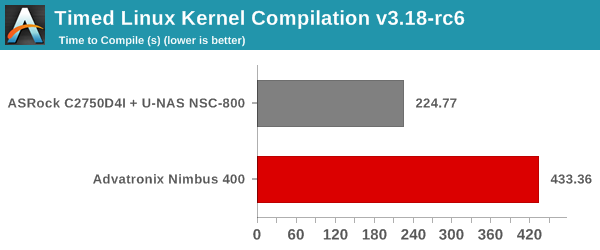
Benchmark numbers for other systems can be viewed on OpenBenchmarking.org
C-Ray
C-Ray is a simple raytracer designed to evaluate the floating point performance of a CPU. This is a multi-threaded test, and the time taken to complete the routine is recorded.
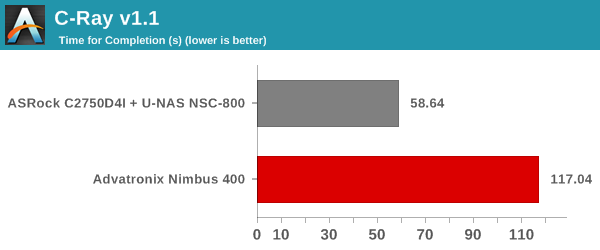
Benchmark numbers for other systems can be viewed on OpenBenchmarking.org










18 Comments
View All Comments
lwatcdr - Wednesday, August 12, 2015 - link
I would really like to see some data using FreeNAS and Windows as well as Ubuntu. With the cost of drivers so low both of the NAS systems offer a huge amount of data for home or business.wintermute000 - Thursday, August 13, 2015 - link
nowhere near enough free RAM for Freenas. 1Gb per Tb is the recommendation. With modern drives @ even RAIDZ1, you do the mathwintermute000 - Thursday, August 13, 2015 - link
Sorry, no idea why but I read it as 4Gb not 4x4Gb, my badBrutalizer - Sunday, August 16, 2015 - link
For zfs, it is recommened to use 1GB ram per 1TB disk space - only if you use deduplication. If not, 4GB in total is enough. Zfs has a very efficient disk cache, if you only have 2GB ram in your server you will not any disk cache, which is no big deal actually. Myself used 1GB ram server for a year with solaris and zfs for a year without problems. Lot of ignorance about zfs. Try it out yourself with 2-4 GB ram server and see it will work fine.DanNeely - Wednesday, August 12, 2015 - link
Aside from the front panel having USB3, this case looks identical to one I bought from Chenbro a few years ago for my DIY nas. I'd be a bit concerned about the quality. The plastic locking half of the handle on one of the drive sleds popped when I pulled it out a month or two ago to add an additional drive to my setup. The metal half was still usable to pull the drive out and it appears to be held in place securely from the rear; but the normal latch mechanism is obviously not working any more.Anonymous Blowhard - Wednesday, August 12, 2015 - link
I'm concerned about the presence of a Marvell SATA controller + FreeBSD based OS like FreeNAS, since there's been many reports of drives performing poorly or dropping out of ZFS pools under high I/O.bobbozzo - Friday, August 14, 2015 - link
Remove USB card and insert IBM 1015 RAID card. Hope cabling is compatible.SirGCal - Wednesday, August 12, 2015 - link
I personally have two 8-drive, one RAID6 and one RAIDZ2, both running Ubuntu. Both of them also run swifter then this. Curious.Ratman6161 - Wednesday, August 12, 2015 - link
Data is a little stilted because the Asrock is using an 8C 2750 vs the 4 C in the Advantronix - so anything CPU sensitive is not really fair - particularly since the Advantronix is available with the 8C CPU.That said, I sort of doubt many people will be running DB's on this sort of machine. And the other tests seem to indicate that the faster CPU doesn't really buy you anything.
And...4 SSD's in a RAID 5? The cost per GB for doing things that way is very high compared to spinning disks and if its being used in a home setting the performance of the SSD's is not needed. comparing prices online I could get 4x WD Black 750 GB drives for almost $100 cheaper than the 4 x 128 GB Vectors. Take a look at the read performance of the two units. Theoretically the Asrock with an 8 drive array should get better read speed than the Nimbus 400 with only 4. But it doesn't leading me to believe that a lot of the SSD's performance is wasted. Spinning disks is probably the most cost effective way to go with these.
lwatcdr - Wednesday, August 12, 2015 - link
Encryption uses up a good amount of CPU time.